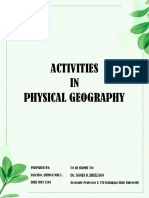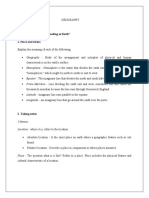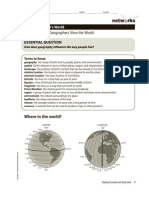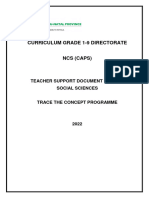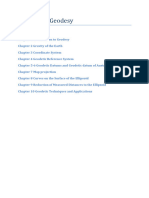Geograghy Grade 10 Critical Thinking Practice Questions
Geograghy Grade 10 Critical Thinking Practice Questions
Uploaded by
RaidioactiveguyCopyright:
Available Formats
Geograghy Grade 10 Critical Thinking Practice Questions
Geograghy Grade 10 Critical Thinking Practice Questions
Uploaded by
RaidioactiveguyOriginal Title
Copyright
Available Formats
Share this document
Did you find this document useful?
Is this content inappropriate?
Copyright:
Available Formats
Geograghy Grade 10 Critical Thinking Practice Questions
Geograghy Grade 10 Critical Thinking Practice Questions
Uploaded by
RaidioactiveguyCopyright:
Available Formats
GEOGRAGHY GRADE 10 CRITICAL THINKING
PRACTICE QUESTIONS
1. How does the etymology of the word "Geography" (derived from
"Geo" and "graph") reflect the scope and purpose of the field?
2. What are some of the values and importance of studying Geography?
How can a strong understanding of Geography benefit both individuals
and society as a whole?
3. Consider the practical applications of latitude and longitude, such as
determining the exact location of a place on a map or calculating
distances between two locations. How have advancements in
technology, like GPS, enhanced the accuracy and convenience of using
latitude and longitude for navigation and mapping?
4. How does the arrangement of the planets in the Solar System,
including their distances from the Sun, affect their physical
characteristics and conditions, such as temperature and the presence of
life?
5. How does the Earth's rotation affect the concept of day and night?
Why does only one part of the Earth's surface face the Sun at a given
time, leading to this cycle?
6. How does Earth's revolution around the Sun determine the length of a
year? What is the significance of a leap year, and how is it calculated?
7. How does the etymology of the word "Geography" (derived from
"Geo" and "graph") reflect the scope and purpose of the field?-[In what
way does the origin of the term "Geography," stemming from the Greek
words "Geo" and "graph," convey the field's objectives and range of
study?]
8. Why is the concept of latitude essential for understanding the Earth's
geography? How does latitude's relationship to the equator help define
important climate zones and geographic regions?
9. Describe the significance of great circles and small circles in
geography. How do they relate to the Earth's shape and the
measurement of distances and locations? Provide examples of great
circles and small circles on the Earth's surface.
10. Explain how lines of longitude, specifically the Prime Meridian (0°),
are used to calculate local time across the world. What implications does
this have for global communication and timekeeping?
11. According to the text, what are some key aspects of Geography that
go beyond simply describing the Earth's surface? How does Geography
explore the relationship between humans and their environment?
12. Earth's rotation results in the occurrence of day and night. How does
this rotation affect daily life and activities on our planet, and how might
life be different if Earth did not rotate?
13. How do the various proofs of Earth's sphericity, such as
circumnavigation, sunrise and sunset times, and lunar eclipses,
contribute to our understanding of the planet's shape? Why are these
pieces of evidence convincing?
14. How do these unique characteristics impact our understanding of the
potential for life beyond Earth, and what factors make Earth a suitable
habitat for life?
15. In what ways does Geography intersect with other subjects, as
mentioned in the text (such as Economics, Agricultural Science,
Government, and History)? Can you provide examples of how
Geography is relevant to these fields?
You might also like
- 1ST Term S1 GeographyDocument20 pages1ST Term S1 GeographyQasim Ibrahim100% (3)
- Understanding Geography Form 1& 2Document121 pagesUnderstanding Geography Form 1& 2JOHN100% (2)
- Illustrated Notes-Form One and Two NotesDocument131 pagesIllustrated Notes-Form One and Two NotesDi'genius Neshmentation100% (3)
- CPL KDR RevisionDocument18 pagesCPL KDR Revisionpaperplanepilot100% (6)
- Exploring The World Cultural GeographyDocument132 pagesExploring The World Cultural GeographyAnonymous SDVeq9qzNo ratings yet
- Activities in Physical GeoDocument16 pagesActivities in Physical GeoJhesica SalcedoNo ratings yet
- Reviewer Ss102Document20 pagesReviewer Ss102Marnelle OcampoNo ratings yet
- University of Phoenix Material: Basics of Astronomy WorksheetDocument2 pagesUniversity of Phoenix Material: Basics of Astronomy WorksheetSean FehrNo ratings yet
- ASSESSMENT 1: "Geo Looking at Earth" 1. Place and Terms: 5 Themes: Location - Where It Is, Refers To The LocationDocument16 pagesASSESSMENT 1: "Geo Looking at Earth" 1. Place and Terms: 5 Themes: Location - Where It Is, Refers To The LocationJuliana Marie ManalaysayNo ratings yet
- Study Guide For Chapter 1 Review All Vocabulary For The Unit in Addition To The Questions Below. Themes of GeographyDocument2 pagesStudy Guide For Chapter 1 Review All Vocabulary For The Unit in Addition To The Questions Below. Themes of Geographyapi-327777794100% (1)
- Geography Past Papers Solved Short QuestionsDocument23 pagesGeography Past Papers Solved Short QuestionsAteeq AhmadNo ratings yet
- 1 - How Geographers View The WorldDocument4 pages1 - How Geographers View The WorldWilliam HoltNo ratings yet
- First Term SS 1 GeographyDocument12 pagesFirst Term SS 1 Geographygracenjoku68No ratings yet
- Physical GeoDocument36 pagesPhysical GeoLalaine Marie BianzonNo ratings yet
- 5º PrimariaDocument51 pages5º PrimariacrsdbfNo ratings yet
- Blue and White Modern Floral Welcome Spring Instagram StoryDocument8 pagesBlue and White Modern Floral Welcome Spring Instagram Storyrajendergariya5No ratings yet
- Valderrama 645 Assign1 Spring 2020Document4 pagesValderrama 645 Assign1 Spring 2020LuisaF.ValderramaNo ratings yet
- 206G - 6YRMTECHUNIT 1 Palanivel 04mar2021Document98 pages206G - 6YRMTECHUNIT 1 Palanivel 04mar2021StarNo ratings yet
- Gps Notes3Document34 pagesGps Notes3Nik AimanNo ratings yet
- 1ST TERM S1 GEOGRAPHY (New)Document24 pages1ST TERM S1 GEOGRAPHY (New)Anonye Solomon100% (1)
- Unit 1 PDFDocument114 pagesUnit 1 PDFFiona Zhang100% (1)
- Course Module World Geography PrelimDocument9 pagesCourse Module World Geography PrelimMarj BinondoNo ratings yet
- Geography Mary Grace RosagaranDocument4 pagesGeography Mary Grace RosagaranMary Grace Lamarroza RosagaranNo ratings yet
- Educ 15: Module 1 & 2Document16 pagesEduc 15: Module 1 & 2Dave CampitaNo ratings yet
- Module-in-SSEd-222-Places-and-Landscape-in-a-Changing-World.docxDocument64 pagesModule-in-SSEd-222-Places-and-Landscape-in-a-Changing-World.docxGwyneth Lorraine AgojoNo ratings yet
- Physical Geography: BY Amer MasoodDocument27 pagesPhysical Geography: BY Amer Masoodmudassar bajwaNo ratings yet
- Satellites and CommunicationDocument11 pagesSatellites and Communicationaronyosi07No ratings yet
- L1 - Introduction To Satellite GeodesyDocument18 pagesL1 - Introduction To Satellite GeodesyAnil SubediNo ratings yet
- GEOGRAPHYDocument13 pagesGEOGRAPHYanir100% (2)
- Gr6.sec Content BackgroundDocument18 pagesGr6.sec Content BackgroundMarkelle RichardNo ratings yet
- Geography f1 Notes PDFDocument167 pagesGeography f1 Notes PDFCyrus BondoNo ratings yet
- Geodesy QuestionsDocument46 pagesGeodesy QuestionsJanna VertulfoNo ratings yet
- Geography Handbook: The Gui River, Guilin, ChinaDocument15 pagesGeography Handbook: The Gui River, Guilin, Chinamshamse000100% (1)
- P7 Revision QuestionsDocument4 pagesP7 Revision Questionsapi-27344426No ratings yet
- Tugas 1-15110071-Adi Suryo Priyo JatmikoDocument5 pagesTugas 1-15110071-Adi Suryo Priyo JatmikoZachary AfifNo ratings yet
- YR7 HASS Introduction PP WK1 2024Document27 pagesYR7 HASS Introduction PP WK1 2024aden.tj.chiaNo ratings yet
- Presentation Lecture 01Document20 pagesPresentation Lecture 01mussarrat zahinNo ratings yet
- Longitude and LatitudeDocument49 pagesLongitude and LatitudeRaidioactiveguyNo ratings yet
- 1ST Term S1 GeographyDocument37 pages1ST Term S1 Geographydavidmadu82No ratings yet
- Trace The Concept Grade 8 Teacher Guide Document 2 240119 101014Document182 pagesTrace The Concept Grade 8 Teacher Guide Document 2 240119 101014Landiwe LangaNo ratings yet
- Importance of GeographyDocument2 pagesImportance of GeographyjenelNo ratings yet
- Module 1 Chapter 1Document17 pagesModule 1 Chapter 1Zedric MauricioNo ratings yet
- GEO Handout W5 U2 L1-4Document6 pagesGEO Handout W5 U2 L1-4Choy DanNo ratings yet
- SURV3510 Geodesy NotesDocument127 pagesSURV3510 Geodesy NotesTom BraundNo ratings yet
- Geo 1Document41 pagesGeo 1netishmidhaNo ratings yet
- Unit 1 Online lecture asdgasgasgzxvDocument154 pagesUnit 1 Online lecture asdgasgasgzxvmadhankumargNo ratings yet
- 11 Geography Notes 01 Geography As A DisciplineDocument4 pages11 Geography Notes 01 Geography As A DisciplineAkash100% (3)
- Questions For Interview of StudentsDocument4 pagesQuestions For Interview of StudentsRiya GupteNo ratings yet
- Philosophies and Methodologies in Geography (GG-CR-16201) - 2nd Semester (CREDIT-IST)Document14 pagesPhilosophies and Methodologies in Geography (GG-CR-16201) - 2nd Semester (CREDIT-IST)singhharshita0001No ratings yet
- Lunar Eclipse Research PaperDocument8 pagesLunar Eclipse Research Papergw0pajg4100% (1)
- T in Order To Study Earth As The Home of People, Geographers Must Develop A Framework That Cuts Into The Connections Between PlacesDocument38 pagesT in Order To Study Earth As The Home of People, Geographers Must Develop A Framework That Cuts Into The Connections Between PlacesMarco ValentinoNo ratings yet
- Geographic Information SystemDocument12 pagesGeographic Information SystemKarl Dave AlmeriaNo ratings yet
- GLS 611 / GSS611 Advanced Geodesy Physical and Satellite GeodesyDocument27 pagesGLS 611 / GSS611 Advanced Geodesy Physical and Satellite GeodesyNaim LotfiNo ratings yet
- Unit 1, Chapter 1, Section 1, Guided Reading WorkbookDocument3 pagesUnit 1, Chapter 1, Section 1, Guided Reading WorkbookJose PoloneyNo ratings yet
- Geography and EconDocument3 pagesGeography and Econsobrien446No ratings yet
- 1st Mid Term Test ReviewDocument4 pages1st Mid Term Test ReviewviranethNo ratings yet
- 2017 Santos - Characterisation of Exoplanet Host Stars - A Window Into Planet FormationDocument10 pages2017 Santos - Characterisation of Exoplanet Host Stars - A Window Into Planet FormationInflatableOkapiNo ratings yet
- Satellite - Geodesy NoteDocument4 pagesSatellite - Geodesy NoteajiboyeNo ratings yet
- Tugas 1 GD2205 Geodesi SatelitDocument4 pagesTugas 1 GD2205 Geodesi SatelitgigihNo ratings yet
- The Observer's Guide to Planetary Motion: Explaining the Cycles of the Night SkyFrom EverandThe Observer's Guide to Planetary Motion: Explaining the Cycles of the Night SkyNo ratings yet
- General Geography Ghatnachakra GS Drishti 3 Pictorial PresentationDocument128 pagesGeneral Geography Ghatnachakra GS Drishti 3 Pictorial PresentationzaidhaseebansariNo ratings yet
- Grade 9 Latitude and LongitudeDocument15 pagesGrade 9 Latitude and LongitudeAkshitaa Pandey100% (1)
- SurveyDocument89 pagesSurveyyt7p4nkw6dNo ratings yet
- Chapter 9 - Earth As A SphereDocument12 pagesChapter 9 - Earth As A SpheresmkpthoeNo ratings yet
- The Armchair Celestial NavigatorDocument121 pagesThe Armchair Celestial Navigatorbjmoose100% (2)
- Destination Geography English 19 July PDFDocument92 pagesDestination Geography English 19 July PDFVintonius Raffaele PRIMUSNo ratings yet
- CH-2 Globe - Latitudes and LongitudesDocument3 pagesCH-2 Globe - Latitudes and LongitudesPriya ChughNo ratings yet
- GEN NAV MID TERM TEST SOLUTION SKYLARKDocument13 pagesGEN NAV MID TERM TEST SOLUTION SKYLARKhrutujabhosleNo ratings yet
- New Rich Text DocumentDocument12 pagesNew Rich Text Documentsonam dorjiNo ratings yet
- Physics 12stdDocument6 pagesPhysics 12stdameyaborkar17No ratings yet
- Locating PlacesDocument34 pagesLocating PlacesACADEMIA FAÑABENo ratings yet
- 1st Year EDS 2nd Paper, 3rd Chapter EVDocument61 pages1st Year EDS 2nd Paper, 3rd Chapter EVKollol KolllolNo ratings yet
- Nautical Almanac 2022 PDFDocument386 pagesNautical Almanac 2022 PDFtonyNo ratings yet
- Geography Term I Revision SheetsDocument4 pagesGeography Term I Revision SheetshasneekNo ratings yet
- Vertical Angles and DirectionDocument20 pagesVertical Angles and Directionacurvz2005No ratings yet
- The Earth-Our Living Planet - Geography Lesson 1: II. Answer The Following Questions BrieflyDocument2 pagesThe Earth-Our Living Planet - Geography Lesson 1: II. Answer The Following Questions BrieflyAgent NorseNo ratings yet
- CE6304 NotesDocument71 pagesCE6304 NotesrangarajNo ratings yet
- 1 First Day and Key TermsDocument45 pages1 First Day and Key TermsRommel LaurencianoNo ratings yet
- 2022 Nautical AlmanacDocument287 pages2022 Nautical AlmanacPlanetarium Uin Walisongo100% (1)
- I. Name of Program Ii. Course Descriptive Title Course CodeDocument24 pagesI. Name of Program Ii. Course Descriptive Title Course CodeAnnhie DeleonNo ratings yet
- Ship NavigationDocument44 pagesShip NavigationReymar Patrimonio100% (2)
- Lesson 3 Direction of Lines, Interior and Deflection Angles, Etc.Document8 pagesLesson 3 Direction of Lines, Interior and Deflection Angles, Etc.Prince Eduard ManucumNo ratings yet
- Orientation and The Solmetric SunEyeDocument16 pagesOrientation and The Solmetric SunEyepeter237No ratings yet
- Answer Questions Based On The Following Map - : Understanding Maps IGS - Grade 6Document3 pagesAnswer Questions Based On The Following Map - : Understanding Maps IGS - Grade 6Vihaan Saxena100% (2)
- NG Compass General Questions 12p 109qDocument12 pagesNG Compass General Questions 12p 109qAds Lyf INNo ratings yet
- UNIT III. Introduction To NavigationDocument8 pagesUNIT III. Introduction To NavigationEvelyn GonzalezNo ratings yet
- Imaginary Lines Climatic ZonesDocument17 pagesImaginary Lines Climatic ZonesMARIA ANDREA LEYAN HALABYNo ratings yet
- Earth Geometry.Document69 pagesEarth Geometry.Kennedy Mwenya75% (4)





